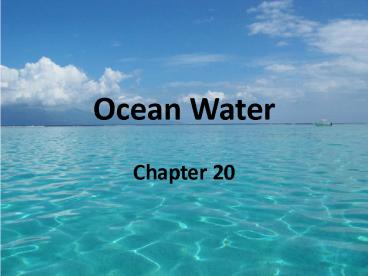Ocean Water - PowerPoint PPT Presentation
1 / 15
Title:
Ocean Water
Description:
Ocean Water Chapter 20 Properties of Ocean Water Dissolved Gases: gases can enter the ocean from streams, volcanoes, organisms, and the atmosphere. – PowerPoint PPT presentation
Number of Views:116
Avg rating:3.0/5.0
Title: Ocean Water
1
Ocean Water
- Chapter 20
2
Properties of Ocean Water
- Dissolved Gases gases can enter the ocean from
streams, volcanoes, organisms, and the
atmosphere. - Gases dissolve more rapidly in cold water than in
warm water. - The oceans are a carbon sink.
3
Properties of Ocean Water
- Dissolved Solids Ocean water is 96.5 pure water
(H20). 3.5 are dissolved solids called sea
salts. - Most common solids (85) are the salt halite made
up of sodium and chloride ions. - Most of the sea salts come from chemical
weathering of rocks on land.
4
Salts in the Ocean
5
Salinity of Ocean Water
- Salinity a measure of the amount of dissolved
salts in a given amount of liquid. - Temperature affects salinity conditions.
Warm/Tropical regions have higher rates of
evaporation therefore have a higher concentration
of salinity (meaning more salts).
6
Temperature of Ocean Water
- Pack Ice a floating layer of sea ice that
completely covers an area of the ocean surface.
Ocean water freezes at about -1.9 C. - Thermocline a layer in a body of water in which
water temperature drops with increased depth
faster than it does in other layers.
7
Temperature of Ocean Water
8
Density of Ocean Water
- Density the ratio of the mass of a substance to
the volume of the substance. - Ocean water becomes denser as it becomes colder
and less dense as it becomes warmer. The densest
ocean water is found at the polar regions causing
it to sink.
9
Color of Ocean Water
- Water absorbs most of the wavelengths or colors
of visible light. Only blue wavelengths tend to
be reflected causing the ocean waters to appear
blue.
10
Life in the Oceans
- Marine organisms depend on 2 major factors for
their survival essential nutrients available in
ocean water and sunlight. - Marine organisms help maintain the chemical
balance of ocean water. They do this by removing
nutrients and gases from the water while
returning others to the ocean.
11
Upwelling
- Upwelling the movement of deep, cold, and
nutrient-rich water to the surface. Upwelling
is caused by offshore movement of surface water.
12
Life in the Oceans
- Most marine organisms live in the upper 100m of
water. - Plankton the mass of mostly microscopic
organisms that float or drift freely in the
waters of aquatic environments. They live within
the sunlit zone and form the base of most food
webs in the ocean.
13
Life in the Oceans
- Nekton all organisms that swim actively in open
water, independent of currents. - Benthos organisms that live at the bottom of
oceans or bodies of fresh water.
14
Ocean Environments
- Benthic Zone the bottom region of oceans and
bodies of fresh water. - Pelagic Zone the region of an ocean or body of
fresh water above the benthic zone.
15
Ocean Environments































